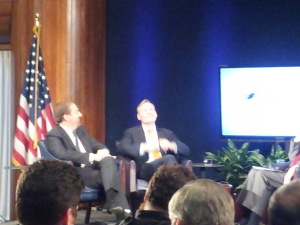You’ve heard of Georgetown Cupcake, right? In case you haven’t (seriously?), the company started in a small space in Georgetown back in 2008 and has now expanded to six locations, including stores in New York City, Los Angeles, Boston, and Atlanta, plus a thriving mail order business. The founders–sisters Katherine Kallinis Berman and Sophie Kallinis Lamontagne–even starred in a reality TV show for TLC called “DC Cupcake.”
But getting to a point where Georgetown Cupcake sells 25,000 cupcakes a day on average did not happen overnight. It took a lot of hard work. Katherine and Sophie shared how they did it at the Inc. Magazine/Capital One Founders Forum last week in Washington, DC, which I attended (it was free and yes, they served cupcakes).
The Georgetown Cupcake ladies shared a lot of information about what it really takes to get a business off the ground (working all hours, every day, and incurring a lot of debt for starters). Their success seems to be tied to how hands-on they are and how personal their motivation is (they learned to make cakes from the grandmother and wanted to recreate that).
They also shared some very interesting marketing insights. From my notes, following are six marketing and communications takeaways:
Use data to drive your business processes and collect data wherever you can
Everyone keeps talking about metrics and analytics. Well, here’s why: data can fuel your bottom line. In Georgetown Cupcake’s case, they used shipping data to choose the locations where they have opened stores. The sisters say you need to ask yourself what information you need, and then collect it.
Prove your business model and have a good product before getting marketing help
You have to have something people want to buy before you market it. The sisters got great publicity early on because lines were forming out the door at the first (and at the time, only) Georgetown location. They were able to get stories in the New York Times and the Washington Post without public relations assistance.
Word of mouth is the best advertising
You haven’t seen ads for Georgetown Cupcake because they don’t advertise. Instead, they rely on word of mouth. Which is how they got those lines out the door in the first place. Which is what led to the major newspaper coverage. Which is what led to the TV show. Which has led to their success.
Use social media (and do it well)
From the start, Georgetown Cupcake has been on social media. First they had a Facebook page, then Twitter, and now Instagram and Pinterest. One of their early social media innovations was to announce a special flavor of the day which you could mention at the store to get a free cupcake. They are still doing it–in fact, I just checked and today’s free flavor is Apple Caramel. Why this works is that it gives people a tangible reason to follow, giving them “inside” knowledge. Katherine says she PERSONALLY handles their Twitter feed, which has 101,000 followers.
Stay true to your brand experience and mission
It was important to the sisters that each new store reflect exactly the brand experience that the first store embodied. They wanted customers to feel a certain way when they walked through the doors, whether in New York or Atlanta. Because brand experience is not easy to replicate, the sisters are not rushing to expand nationwide (although you can order the cupcakes to be shipped anywhere in the U.S.).
Focus on employee communications
Because the sisters cannot be at all the locations every day, they keep in touch with their employees constantly. They have a weekly internal newsletter, and they email each store several times a day. All employees are trained to understand the company’s mission.
In a world where cupcakes chains have come and gone, it is interesting to see that Georgetown Cupcake is still doing well. Perhaps it’s because the sisters are so involved and committed to their business. In any case, it was fascinating to hear them talk about their business.



